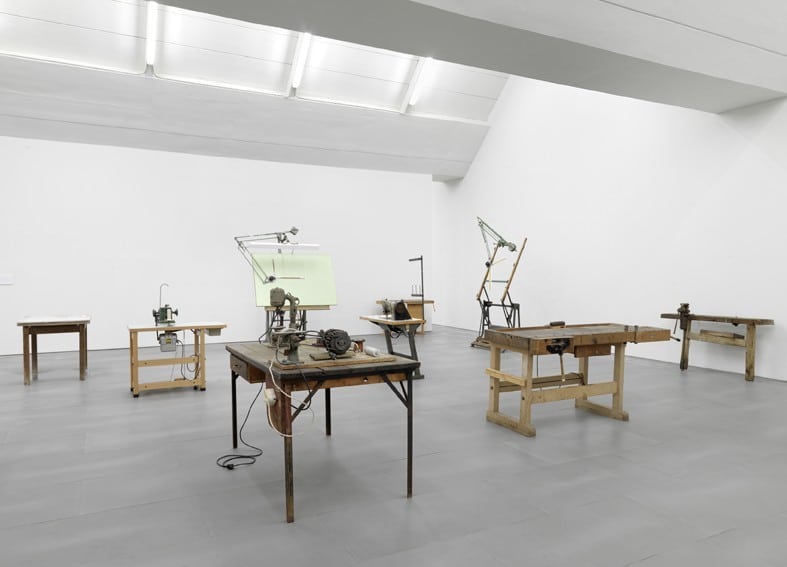
In family workbenches, Asta Gröting’s first solo exhibition at carlier | gebauer positions the artist jobs by fourteen artist parents. These fourteen workbenches open up the family as well as the work between the present and the past as action spaces. Gröting shows them as artifacts of a prehistory whose peculiarities are present in the gallery space. Family workbenches shows in the look back a new present – an understanding of the work also outside art.
Gröting translates sculptural thinking into a wide variety of media in her broad artistic practice since the mid-1980s. She creates works that translate psychological and physical perspectives on the relationships of people into forms whose clarity makes the complexity of these relationships tangible. In family workbenches, Gröting follows the sculpture into his everyday counterpart, the works.
Familienwerkbänke brings together fourteen work furniture from thirteen families and thus produces an aesthetic space in which forms of work and work patterns are visualized that, socially identified between hobby and wage labor, are hardly ever perceived as a creative or aesthetic practice. Drawing tables, wooden benches, sewing machines, vises and kitchen tables appear here as creative as well as designed media. At Gröting, the workbenches become the expression of an unlimited artistic practice whose starting points can be found in every social work.
And yet, in her composition, Asta Gröting does not simply assign art to the craft, but rather expands the perceptions of her parents’ activities with the gaze that shaped the artistic profiles of her children. Thus, each workbench has its surname, as well as the key data of its history, from which the artistic practice of the children has been promoted as a post-history. Craft itself becomes a question of the visibility of what the artists Gröting asked for the family workbenches saw in their parents’ occupations. Many of the objects show work surfaces of no longer existent works, mechanical productions, which survived only as a hobby. And yet these pieces of furniture remain up-to-date, since they changed their character through their individual work. In them, the will to design survives that the artists in question looked at when looking at their family, and which comes to the fore in Gröting’s work. At the same time, Gröting’s installation of the fourteen workbenches brings together a new family, the artist’s family of choice. She asked those who are personally or artistically close to her. In this social search for the prehistory of one’s own sewing, the art field opened between the Ikea table of the sealing mother, an assembly line worker, and the working table of an aerospace physicist, who reconstructed old ship models as a socially differentiated field, that in generations, Composed of classes and genders. At the same time, Gröting’s installation of the fourteen workbenches brings together a new family, the artist’s family of choice. She asked those who are personally or artistically close to her. In this social search for the prehistory of one’s own sewing, the art field opened between the Ikea table of the sealing mother, an assembly line worker, and the working table of an aerospace physicist, who reconstructed old ship models as a socially differentiated field, that in generations, Composed of classes and genders. At the same time, Gröting’s installation of the fourteen workbenches brings together a new family, the artist’s family of choice. She asked those who are personally or artistically close to her. In this social search for the prehistory of one’s own sewing, the art field opened between the Ikea table of the sealing mother, an assembly line worker, and the working table of an aerospace physicist, who reconstructed old ship models as a socially differentiated field, that in generations, Composed of classes and genders.
Used in family workbenches, these tables, benches and counters have an unprecedented level of precision. Their functions are distinguished, their origin, their generation, their treatment and their role in the gender and social affiliation of their owners. Gröting’s Family Workbenches shows a social as an aesthetic order and takes sides for a formative understanding beyond the discipline of the media. Her Work Family Workbenches brings the aspects of art as work on the material and as a living of a social experience into a common setting in which the workbenches themselves act as figures, as aesthetic bodies in formation.